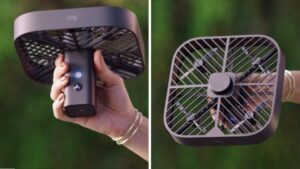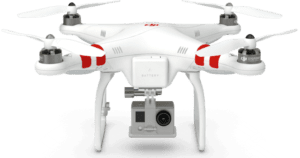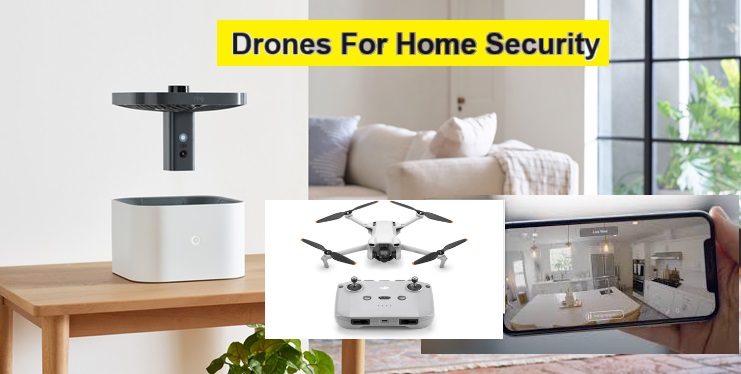How to Use Drones for Home Security
Selection of Drone for surveillance of home
When using a drone for home surveillance, there are several factors to consider, including the type of drone, features, and best practices. Here’s a more detailed guide:
1. Choose the Right Drone:
- Camera Quality: Opt for a drone with a high-quality camera for clear surveillance footage. Look for features like HD resolution, night vision, and stabilization.
- Flight Time: Consider a drone with a decent flight time to cover more area without frequent recharging.
- Range: Choose a drone with a sufficient range to cover your entire property.

Drone sizes for home security
2. Camera Features:
- Pan and Tilt: A camera with pan and tilt capabilities allows you to adjust the view remotely.
- Zoom: Optical zoom capabilities can be beneficial for focusing on specific areas.
- Storage: Drones with onboard storage or the ability to transmit footage in real time are advantageous.
3. Remote Monitoring:
- Set up a dedicated monitoring station where you can view the live feed from the drone. This can be a computer, tablet, or a dedicated monitor.
4. Flight Planning:
- Plan flight paths to cover the entire property systematically. This ensures comprehensive surveillance without missing any areas.
5. Security Measures:
- Enable password protection and encryption for your drone to prevent unauthorized access.
6. Privacy Considerations:
- Be mindful of your neighbors’ privacy. Avoid flying over their properties, and position the camera to capture only your premises.
7. Weather Considerations:
- Avoid flying the drone in adverse weather conditions. Wind, rain, and extreme temperatures can affect its performance.
8. Legal Compliance:
- Familiarize yourself with local drone regulations and ensure compliance. This includes respecting no-fly zones and adhering to privacy laws.
9. Battery Management:
- Keep spare batteries on hand to extend surveillance periods. Be mindful of battery life and plan flights accordingly.
10. Obstacle Avoidance:
- Drones with obstacle avoidance sensors can prevent collisions and enhance safety during flights.
11. Noise Level:
- Consider the noise level of the drone, especially if you are using it in a residential area. Quieter drones are less likely to disturb neighbors.
12. Regular Maintenance:
- Regularly inspect and maintain your drone to ensure optimal performance. Check propellers, motors, and other components for wear and tear.
13. Training:
- If you’re new to flying drones, take the time to practice and become familiar with the controls before using it for surveillance.
14. Emergency Procedures:
- Be prepared for emergencies, such as a loss of signal or low battery. Have a plan in place to safely land the drone in case of unexpected issues.
15. Communication:
- Keep lines of communication open with neighbors. Inform them about your drone usage and address any concerns they may have.
- Remember, responsible drone use is crucial. Always prioritize safety, privacy, and legal compliance when using a drone for home surveillance.

Popular Home Security Drones
- There isn’t a specific category of drones designed exclusively for home security.
- However, several consumer drones with advanced features can be adapted for home security purposes.
- Here are some popular consumer drones known for their capabilities that could be useful for home security:
DJI Mavic Series:
-
- Models: DJI Mavic Air 2, Mavic 3, Mavic Mini, etc.
- Features: High-resolution cameras, obstacle avoidance, GPS navigation, and relatively compact designs.

DJI Phantom Series:
-
- Models: DJI Phantom 4 Pro, Phantom 4 RTK, etc.
- Features: Professional-grade cameras, long flight times, obstacle avoidance, and advanced flight modes.
DJI Inspire Series:
-
- Models: DJI Inspire 2, Inspire 1, etc.
- Features: Dual-operator control, interchangeable cameras, and advanced flight capabilities.

Autel Robotics EVO Series:
-
- Models: Autel Robotics EVO Lite+, EVO Nano+, etc.
- Features: High-resolution cameras, obstacle avoidance, and long flight times.

Skydio 2 Series Drone
- This drone is known for advanced obstacle avoidance and tracking capabilities. It’s designed to navigate complex environments autonomously.
-
Parrot Anafi USA:
-
- Features: Made for professional applications, it offers high-resolution cameras, thermal imaging, and secure data storage.
- Please note that the availability and popularity of drone models may change over time, and new models may be released.
- Additionally, always check for the latest local regulations regarding drone usage, as they can impact how you use drones for home security.
- Before purchasing a drone for home security, carefully assess your specific needs, such as the size of the area you want to monitor, the required resolution for surveillance footage, and any specific features like night vision or thermal imaging.
- Furthermore, be sure to stay updated on the latest drone technologies and models in the market
Summary
- By following these steps and maintaining a responsible approach to drone usage, you can enhance your home security with the help of drones.
- Always prioritize safety, legal compliance, and privacy considerations when implementing drones for home security.
References
- Drones Rules in India, Ministry of civil aviation
- USA Drones Rules, FAA GOV



